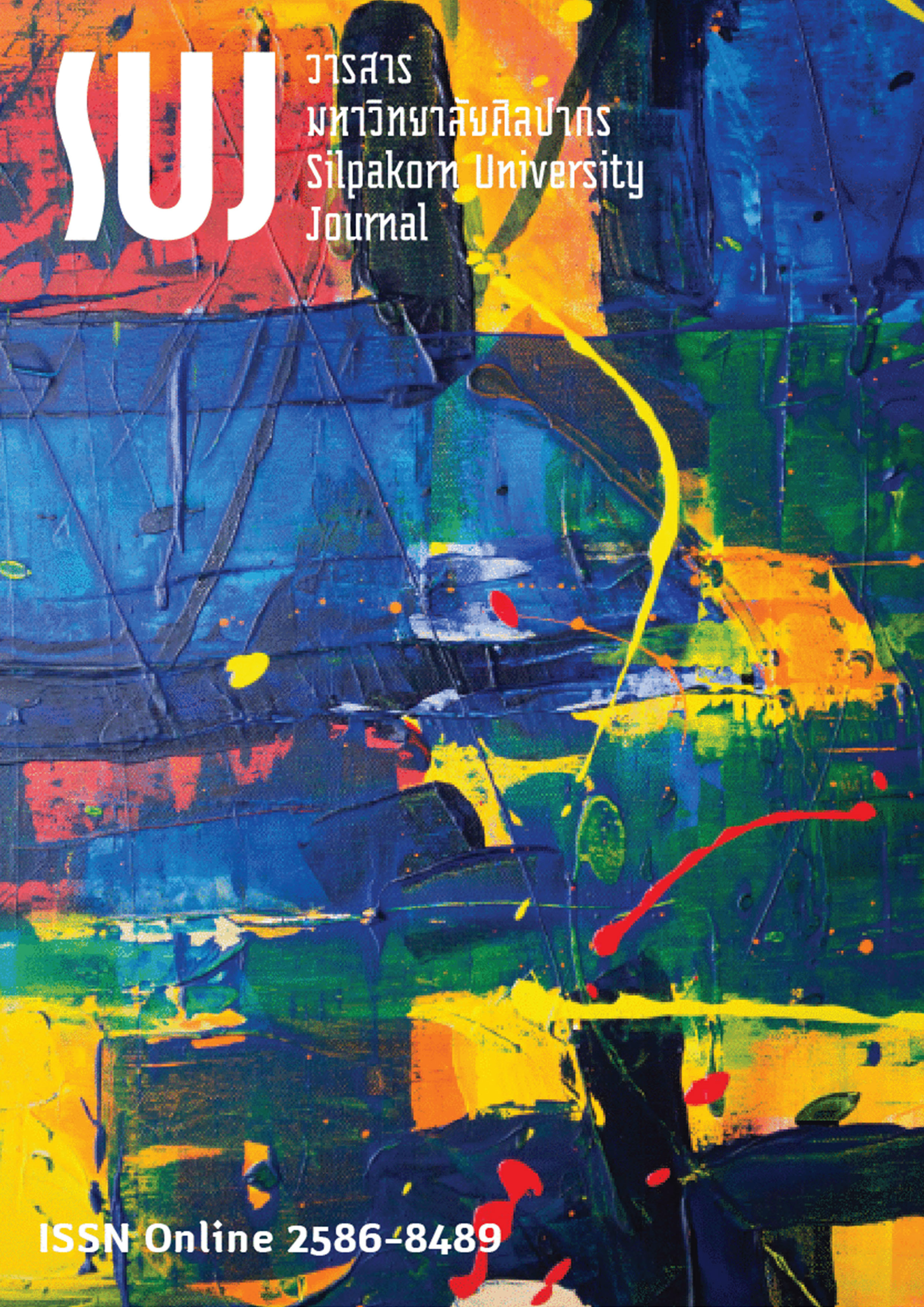การพัฒนาความสามารถทางการพูดภาษาจีนของนักเรียนระดับมัธยมศึกษาตอนปลายในจังหวัดลำปาง ด้วยรูปแบบการสอนตามหลักภาษาศาสตร์เชิงประสาทวิทยา (The development of an instructional model based on neuro-linguistics programming for the improvement of the Chinese speaking skill of upper-secondary school students in Lampang Province)
Main Article Content
Abstract
การวิจัยครั้งนี้มีวัตถุประสงค์เพื่อพัฒนาและศึกษาประสิทธิผลของรูปแบบการสอนตามหลักภาษาศาสตร์เชิงประสาทวิทยาในการพัฒนาความสามารถทางการพูดภาษาจีนของนักเรียนระดับมัธยมศึกษาตอนปลายในจังหวัดลำปาง โดยแบ่งกลุ่มตัวอย่างออกเป็น 2 กลุ่ม คือ 1) กลุ่มตัวอย่างที่ใช้ศึกษาบริบทและสภาพปัญหาการจัดการเรียนการสอนภาษาจีนในระดับชั้นมัธยมศึกษาตอนปลายแผนการเรียนศิลป์ภาษาจีน โดยการสังเกตครูสอนภาษาจีนจำนวน 12 คน และสัมภาษณ์นักเรียนจำนวน 358 คน และ 2) กลุ่มตัวอย่างที่ทดลองใช้รูปแบบการสอนที่พัฒนาขึ้น โดยเป็นครูสอนภาษาจีนระดับชั้นมัธยมศึกษาปีที่ 5 จำนวน 5 คน และนักเรียนจำนวน 158 คน ผลการวิจัยพบว่า รูปแบบการสอนที่พัฒนาขึ้นประกอบด้วยกระบวนการจัดกิจกรรมการเรียนรู้ 5 ขั้นตอน ได้แก่ ขั้นสร้างเป้าหมาย ขั้นการเรียนรู้ ขั้นฝึกการเชื่อมโยง ขั้นแสดงผลการเรียนรู้ และ ขั้นประเมินความสามารถ โดยความรู้และความเข้าใจในการเลือกใช้คำและประโยคของนักเรียนกลุ่มเก่ง ปานกลาง และ อ่อนหลังการทดลองเรียนสูงกว่าก่อนการทดลองเรียนอย่างมีนัยสำคัญทางสถิติที่ระดับ .01 และระหว่างเรียนนักเรียนทุกกลุ่มเรียนมีความสามารถทางการพูดภาษาจีนที่ดีขึ้นอย่างมีนัยสำคัญทางสถิติที่ระดับ .01 ในทุกช่วงเวลาของการประเมิน
The objectives of this research were to develop an instructional model based on neuro-linguistics programming for the development of Chinese speaking ability among upper secondary school students and to study its effectiveness. The samples were divided into 2 groups. The first one was a sample group that was used to study the context and the condition of problems of Chinese language teaching and learning among upper secondary school students who were studying in Language-Arts Program (Chinese language). The sample group were 12 Chinese language teachers and their 358 students. The participants’ teaching behaviors were observed and their students were interviewed. The second group consisted of 5 Chinese language teachers of Mathayom 5 and 158 students. This group was experimented with the developed teaching model. The results of the research revealed that an instructional model comprises a five-step process of learning activities, namely goal-building stage, learning stage, training for linking stage, showing results of the learning stage, and assessing ability stage. After the experiment, it was found that students’ knowledge and comprehension of word and sentence selection were significantly higher at the .05 level, and, when using an instructional models, the students in all group had improvements in their Chinese speaking skill after the experiment. They have significantly higher results at the .01 level.
Downloads
Article Details

This work is licensed under a Creative Commons Attribution-NonCommercial-NoDerivatives 4.0 International License.
References
Asher, J., & Adamski, C. (1982). Learning Another Language Through Actions: The Complete Teacher’s Guidebook. California: Sky Oaks Productions.
Bureau of Academic Affairs and Education Standards. (2013). Indicators and Content for Learning Chinese, Foreign Language Learning Group According to the Core Curriculum of Basic Education 2008 (ตัวชี้วัดและสาระการเรียนรู้ภาษาจีนกลุ่มสาระการเรียนรู้ภาษาต่างประเทศ ตามหลักสูตรแกนกลางการศึกษาขั้นพื้นฐาน พุทธศักราช 2551). Bangkok: Office of the Welfare Promotion Commission for Teachers and Education Personnel.
Chinese Testing International. (n.d.). Scoring criteria by HSKK (Chinese Proficiency Speaking Test) model. [Online]. Retrieved June 16, 2021 from http://www.chinesetest.cn/index.do
Dilts, R., & Delozier, J. (2000). Encyclopedia of Systemic NLP and NLP New Coding. California: NLP University Press.
Donkaewbua, Sangrawee. (1995). Linguistics for English Teachers (ภาษาศาสตร์สำหรับครูสอนภาษาอังกฤษ). Bangkok: Chulalongkorn University Press.
Hymes, D. (1972). Models of Interaction of Language and Social Life. In J. Gumperz, & D. Hymes (Eds.), Directions in Sociolinguistics: The Ethnography of Communication, (pp. 35-71). New York: Holt, Rinehart and Winston.
Isarapreeda, Prasart, & Thongvisase, Teeraprapa. (2017). Teacher-Student Interpersonal Behavior: Theoretical Model, Assessment, and Research Review (พฤติกรรมสัมพันธภาพระหว่างผู้สอนกับผู้เรียน: รูปแบบเชิงทฤษฎีการวัด และปริทัศน์งานวิจัย). Journal of Education Studies, 45(3): 206-220.
Jaitiang, Arporn. (2010). Teaching Principles (Revised Edition) (หลักการสอน (ฉบับปรับปรุง)). Bangkok: Odeon Store.
Kengpenkhae, Nongyao. (2015, April 28). Methods of Teaching Language According to the Principles of Educational Linguistics (ระเบียบวิธีสอนภาษาตามหลักวิชาภาษาศาสตร์การศึกษา). [Online]. Retrieved March 21, 2020 from http://thaineurolinguistic1.blogspot.com
Khanti, Anchalika, Intasing, Somkiart, & Konthieng, Soontaree. (2019). Guidelines for Developing Chinese Speaking Skills for Basic Communication (แนวทางการพัฒนาทักษะการพูดภาษาจีนเพื่อการสื่อสารเบื้องต้น). CMU Journal of Education, 3(1): 34-41.
Pattison, P. (1987). Developing Communication Skills: A Practical Handbook for Language Teachers, with Examples in English, French and German. Cambridge: Cambridge University Press.
Potcharapanpong, Sasiwan. (2005). Development of a Teaching Model Based on Integrated Neuro-Linguistic Programming and Communicative Approach for Developing French Speaking and Writing Skills of Students at Key Stage Four (การพัฒนารูปแบบการสอนที่ผสมผสานวิธีการสอนแบบภาษาศาสตร์เชิงประสาทวิทยาและแนวคิดภาษาเพื่อการสื่อสารเพื่อพัฒนาทักษะการพูดและทักษะการเขียนภาษาฝรั่งเศส สำหรับนักเรียนช่วงชั้นที่ 4). Doctoral dissertation, Chulalongkorn University, Bangkok, Thailand. [Online]. Retrieved March 21, 2020 from https://dric.nrct.go.th
Rayati, M. (2021). Neuro-linguistic Programming and its Applicability in EFL Classrooms: Perceptions of NLP-Trained English Teachers. Language Teaching Research Quarterly, 24: 44-64.
Revell, J., & Norman, S. (1999). Handing Over NPL-based Activities for Language Learning. Gosport: Ashford Colour Press.
Richards, J. C., & Rodgers, T. S. (2001). Approaches and Methods in Language Teaching. New York: Cambridge University Press.
Rodjanapaitoon, Rungnapa, & Sumettikoon, Piyapong. (2015). Chinese Language Teaching and Learning Strategies of Phanthong School, Chonburi (กลยุทธ์การจัดการเรียนการสอนภาษาจีนของโรงเรียนพานทองจังหวัดชลบุรี). An Online Journal of Education, 10(3): 235-245.
The Secretariat of the Education Council. (2016). Research Report for the Development of Chinese Language Teaching in Thailand Synthesizes an Overview (รายงานการวิจัยเพื่อพัฒนาการเรียนการสอนภาษาจีนในประเทศไทยสังเคราะห์ภาพรวม). Bangkok: Phrikwaan Graphics Press.
Ungwattanakul, Sumitra. (1997). Methods of Teaching English as a Foreign Language (วิธีการสอนภาษาอังกฤษเป็นภาษาต่างประเทศ). Bangkok: Chulalongkorn University Press.
Wisedjinda, Jintana, & Chitradub, Somphong. (2018). Guidelines for Chinese Instruction in Upper Secondary Schools (แนวทางการจัดการเรียนการสอนภาษาจีนระดับมัธยมศึกษาตอนปลาย). Veridian E-Journal, Silpakorn University, 11(2): 445-455.
Wubbles, Th., & Brekelmans, M. (2005). Two Decades of Research on Teacher-Student Relationships in Class. International Journal of Educational Research, 43(1-2): 6-24.


